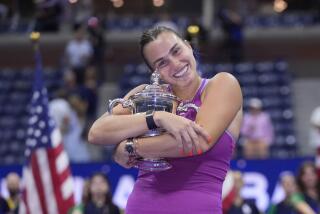Sabatini’s New Approach to Tennis Pays Off
- Share via
After years of falling short, Gabriela Sabatini of Argentina finally earned her first Grand Slam tennis title this year and may well be on her way to the top of the women’s rankings in 1991.
Few would have predicted that Sabatini would win the women’s title at the U.S. Open. Her results this year hadn’t compared to the performances of this year’s top players. When the contenders were mentioned, Sabatini’s name was always left out.
So what a moment it was for Sabatini when she upset the world’s No. 1 player, two-time defending U.S. Open champ Steffi Graf, to clinch her first Grand Slam championship. She had become the lowest seed (No. 5) to win the title in 22 years and the first woman from Argentina to win a Grand Slam event. She also became the first South American to win the U.S. Open since Brazil’s Maria Bueno in 1966.
Sabatini’s parents were not in the stands, which was unusual. She had long been seen only in the company of her family. But earlier in the year she had decided it was time to assume more responsibility for herself by traveling with a smaller entourage.
At 20, she has had a life of glory that sounds like a fairy tale. She has earned millions and won standing ovations from a country where she is adored as a national hero. She even has a perfume named after her.
But for Sabatini there is more to accomplish than fame and fortune. “My goal is to be No. 1,” she has said repeatedly. “I try to work hard and not think how long that will take.”
If there is ever a chance for her to rise to the top of the tennis rankings, it will be in 1991. Graf no longer has a firm hold on the throne. The German started this year well by winning the Australian Open but did not come through in the other Grand Slam events--Wimbledon and the French and U.S. Opens.
Last month, in the season-ending Virginia Slims Championships at Madison Square Garden, Graf lost again to Sabatini, 6-4, 6-4. In the tournament final, Monica Seles beat Sabatini in the first five-set women’s match since 1901.
It looks as though Graf, Seles and Sabatini will be fighting for No. 1 next year.
For Sabatini, 1990 started poorly when an ankle injury that forced her to withdraw from the Australian Open. She came back to win the Virginia Slims of Florida, but then hit a long dry spell.
Her low point had come after her disappointing fourth-round loss to Jana Novotna at the French Open. Until then, she was content to let others dictate her life. She was comfortable with a sheltered existence.
Her friends came from a group of players like fellow Argentinians Mercedes Paz and Betinna Fulco. She was rarely seen away from the eye of her family.
By June it was clear from her results that this lifestyle no longer worked. She had become stagnant, had lost motivation and was in need of a change. It was at this time that she took an active role in planning her life.
She fired her longtime coach, Angel Gimenez, and hired a former touring pro from Brazil, Carlos Kirmayr.
She hired a psychologist, Ted Loehr, to help her gain an awareness of who she was. She quit traveling with her large family entourage and now is accompanied on the tour only by her brother, Osvaldo Jr.
After the U.S. Open, it was clear that the changes she had made were having a positive effect. Her tennis had improved tremendously from the beginning of the year. Even other players on the tour began to notice a difference. “Six months ago, Gaby didn’t progress the way I thought she would,” Pam Shriver said. “I had kind of lost respect for her game. Everything was just bash, bash, bash. She seems to be working harder now and suddenly she has a greater variety of shots.”
Sabatini’s improvement should be partly credited to her new coach, Kirmayr. “When we began working together she had lost the idea of how to play,” Kirmayr said. “She didn’t know what to do, but she has worked very hard without ever complaining.”
Kirmayr intensified her workouts and pushed her to a training level that she had never reached before. He has helped improve her serve, which had been the weak link in her game, and encouraged her to attack more often; her heavy-topspin ground strokes had not been enough to beat the best consistently. In her match against Graf at the Open, she jumped on every short ball without hesitation and charged to the net.
But the most important aspect of these new changes is a renewed belief that she can be No. 1. The monkey is off her back after winning the Open, and there is less talk about her failed potential.
The fact that she’s growing up may also help her.
Some players have already seen a change in her personality this year. Her close friends say she has started to become more outgoing. For example, she doesn’t hold back her enthusiasm any more. When the music starts at the players’ parties, she usually is one of the first on the dance floor. She’s also quicker to smile and seems much less bashful about having a conversation with other players her age.
Things are looking up for Sabatini. Her fans in this country and in Argentina are hopeful that 1991 will be her year.
Fernandez is special events director and tennis professional at Warner Center Club in Woodland Hills. She was NCAA singles champion in 1981 while at USC and ranked in the top 20 worldwide.
More to Read
Go beyond the scoreboard
Get the latest on L.A.'s teams in the daily Sports Report newsletter.
You may occasionally receive promotional content from the Los Angeles Times.










